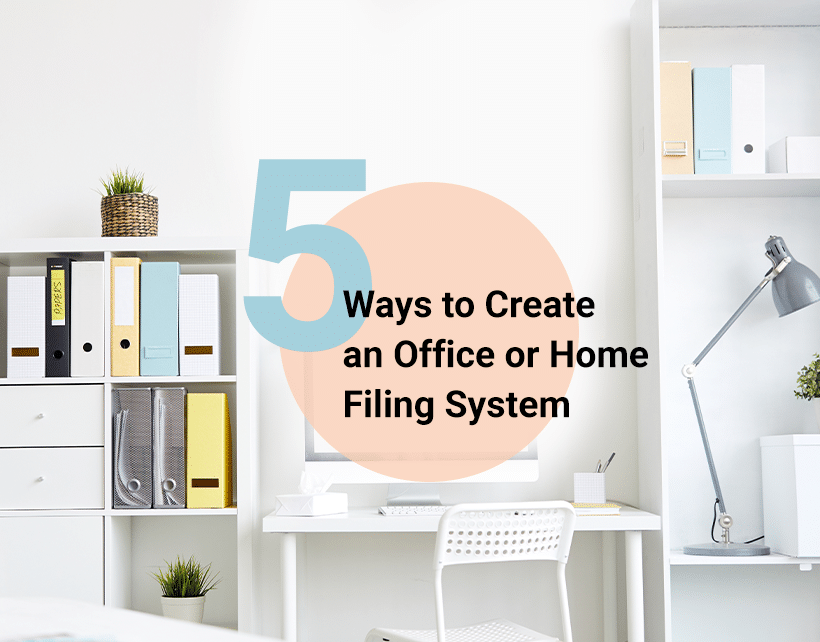
5 Ways to Create an Office or Home Filing System
Last Updated on 06/10/2025
Discovering an office storage solution that organises your essential documents and files efficiently, making retrieval easy, is an integral aspect of maintaining a well-functioning office. Whether you’re trying to work out how to create a filing system for an office or how to set up a home filing system, we can help! Organise your home filing system or hundreds of files in your office by making sure your filing cabinets have a sense of order and structure.
Here at Viking, we know the importance of keeping your office organised, no matter how big or small. That’s why we’ve put together this guide showing you how to create a filing system.
1. Find the right file cabinet storage idea for your needs
There are many ways that you can store files and important documents, and the first step is figuring out which one works best for you. This can take into account anything from the amount of space you have available (office storage solutions for small spaces can be helpful if you’re struggling for space) to the number of different files that you’re filing. Once you’ve worked this out, you’ll be able to find a filing cabinet that fits your needs in terms of space, office aesthetic, and the type of files.
Filing cabinets come in all kinds of shapes and sizes, as well as different materials and colours. If you’re buying them for a home office, you may want something that fits in with the existing décor of the room, such as a wooden filing cabinet. For those looking to implement a filing system into a corporate office, size and security may be of importance, so you may want to look for something with four or more lockable drawers.
2. Separate your files into different filing cabinet folders
Once you’ve purchased the filing cabinet that you’ll be using for your office or home filing system, it’s time to get to work organising the folders that you’ll be putting into the filing cabinet. Consider separating your files into different piles, for instance:
- To-do: If you have any files that still require some sort of action before discarding or archiving away, this is the pile they belong to. It could be an unpaid invoice or an expense claim. Make sure these stay separate and don’t get mixed up with anything that’s due to be thrown away or archived.
- Archive: One of the main purposes of your filing system will be to safely store away documents and make it easy to find them again, should you require them for reference. This pile may end up being one of the biggest and could require further sorting– we’ll come to that in step three.
- Recycle: Anything that you don’t need and doesn’t contain sensitive information can go straight into the recycling pile. This will help you declutter, whilst also ensuring you’re doing your bit to be sustainable.
- Shred: A paper shredder is a great way to get rid of potentially sensitive documents. If you don’t need it anymore and it contains this type of information, shred it. And if it gets jammed? Just read our guide to unjamming a shredder.
3. Find the most efficient and best way to organise documents
When working out how to create a filing system for the most efficient and effective results, folders and labels will be your friend. Each filing system will look completely different depending on the number of different documents you have to file away, so there’s no right or wrong way of doing this. There are a few tips that you can follow in order to ensure you’ll be happy with the results:
- Use coloured folders to categorise your documents. This is one of the simplest ways to organise your workspace. For instance, use a blue folder for filing important memos and a red one for the invoices. This visual method helps in keeping important paperwork in order and easy to find.
- Make sure your labels are clear and easy to read, as this will help you swiftly navigate through your filing system.
4. Keep your household filing system separate
If you are creating a filing system in a home office, try and make sure that any personal documents are kept well away from business documents. It’s a great idea to keep a personal archive file for things such as birth certificates, insurance documents, receipts, and guarantees etc, but make sure these are clearly marked away from work documents. There’s nothing worse than searching for an important tax return and having to wade through the precious pictures your five-year-old once drew for you!
5. Regularly organise your office or home filing system
Once you’ve taken the time to set up a filing system, don’t fall into the trap of thinking your work is completely done! Keeping on top of your filing system is vitally important, otherwise you run the risk of it falling into disarray and becoming counter-productive. Follow these few tips to keep up to date with your filing system:
- Regularly file: Don’t leave piles of paperwork in your ‘to-do’ pile. Make sure you’re regularly filing things away.
- Don’t get lazy: As tempting as it might seem, don’t throw paperwork into your filing cabinet without following your own system. Otherwise, all your hard work will be for nothing.
- Be ruthless: If you’re not convinced that you’ll ever need a document again– just get rid of it. Your filing system can become clogged up very quickly by items that have no use.
Whether it’s a filing system for home office, or a corporate office filing system, the best way to organise documents can vary from person to person. Following a few of these tips should help you implement something that works for you, and the important next step is keeping up with it. All the best in your filing journey!









